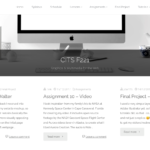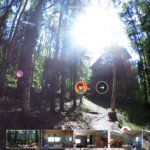Course Architecture
Give students a solid foundation for navigating your course.
What is Course Architecture?
Course architecture is a way of talking about the structure of a course. If your course were a physical space and students were to walk in, prepared for a learning experience, the architecture of your course is all the features that direct students through that experience. A course with intuitive and reliable structure lets students focus on the material of the course rather than struggle to navigate it. Whether you are teaching online or simply using an online interface to communicate with students, you’re the architect of this virtual space and you’re responsible for using good design principles. See below for a breakdown of these principles. The time that you put into these efforts before the class begins will save you considerable time and frustration after your class gets going.

How Can I Create Effective Architecture for My Course?
Navigation
Imagine that the “landing page” of your course (the first page the students see) is a map. Your students will use this map to find their way through the course and will benefit most if you keep it simple. Use this page as a place to welcome students and begin guiding them through the course. If they are new, where should they go first? If they have a question, can you make the resources that are likely to contain an answer – the syllabus, course schedule, etc. – clearly and easily accessible?
In addition to the actual content on this landing page, you have a menu bar that lists possible first steps a student might want to take away from this main page. In Canvas, that menu is on the left side of the screen. In WordPress, and on most websites, the menu is a horizontal bar across the top of the screen.
Consider how you organize this menu. What are the 5-8 most important links for students to have? Make those your top-level menu items and categorize the rest within those (they may appear in a “drop-down menu”). Avoid creating too many levels within your menus. The deeper the menu, the harder your materials become to find.
Clear directions for getting started
Create a “Getting Started” area to welcome students to the course and guide them through your initial set of expectations. You could make an announcement in Canvas or create a “Getting Started” page on WordPress. Try creating a visual tour of the course using screenshots, or make a video and post it in this area. Point students toward important resources and areas in your course. Where can they find the syllabus? Assignments? Will you be using any other tools in the course that they should know about?
In addition to introducing students to the structure of your course, this is an opportunity to introduce yourself, your interest in this course, and your expectations for the semester. Take your time with this – first impressions stick!
First Contact assignment for asynchronous courses
The “First Contact” assignment is meant to be a low-stakes undertaking for students and instructors, serving primarily to make sure students who have enrolled in the course are actually still willing and able to participate. It helps to make this assignment something that can be done quickly using some of the tools that you’ll be using in the course. Having a First Contact assignment due date fall before the deadline for tuition refunds would benefit students who aren’t prepared for an online class. As some samples of First Contact assignments, you could have students:
- email you, the instructor, with an introduction and to tell you if they have or have not received the books/materials for the class
- introduce themselves on a discussion board or blog
- take a syllabus quiz
- participate in a Canvas (or other course management system) scavenger hunt
Check out this Teaching Tip for more first contact assignment ideas!
Chunking
“Chunking” means grouping material into “modules” (or “units”) and including everything the students need within that module to complete the lesson. Each module should include checklists for each week as well as goals and objectives that refer back to course outcomes.
Visual Consistency
- The various course management systems (Canvas, Blackboard, Moodle, etc.) have fairly uniform styles and layout options, so it’s important to understand how the visual element of your course affects your students’ interaction with the content. Some important things to remember:
- use a consistent font style and size
- use color and font formatting sparingly to make an emphasis — while it may be tempting to make your course more visually interesting by playing with font color, size, and type, be careful not to venture into “circus’ territory with chaotic colors and formatting
- don’t be afraid of white space — consider it a visual version of a conceptual pause in the conversation
- avoid underlining words, which can be confused with a link
- be sure the images you use are appropriate to the content they accompany
Questions and Considerations
Solid course architecture is important for any course, especially online where students don’t always have a classroom teacher to guide them. Follow the design principles above to make your course is navigable for your students.
Note that a solid architecture in not necessarily synonymous with a simple one. You can build a complex course, one that asks students to consider its form, to seek out the material by different paths. This kind of complexity can engage students and help build community in the class. Don’t mistake complication and complexity: complicated architecture is hard to navigate without purpose; complex architecture poses challenges to students in its form, and is intentional about what it asks of students.
In Practice
We want you to find ways to make the course yours visually and functionally, however we also realize that this is not within everyone’s comfort zone. Visit Canvas Commons (via the left-hand navigational bar in Canvas) to download course templates created specifically for UAF.
But first, have a look at some courses that are a bit different:

Fundamentals of Graphics, Animation, Audio, and Video for the Web
Taught by Christen Booth, this course includes Tutorials and a Resources section, both available across the site via the main menu. The course’s weekly lessons are also thorough and clearly organized.

Research Writing
This Research Writing course takes architectural risks by being built mostly in a 360-degree environment. The landing page makes clear why these choices were made, and invites students to explore.
Watch: Planning and Building a Course
Research Foundations
Cook., D.A. & Dupras, D.M. (2004) A Practical Guide To Developing Effective Web-based Learning. Journal of General Internal Medicine, Vol 19, 698-707.
Hassan, A. E., & Ibrahim, M. E. (2010). Designing quality e-learning environments for higher education. Educational Research, 1(6), 186-197.
Murray, M. C., Pérez, J., Geist, D. B., & Hedrick, A. (2012). Student interaction with online course content: Build it and they might come. Journal of Information Technology Education: Research, 11(1), 125.
